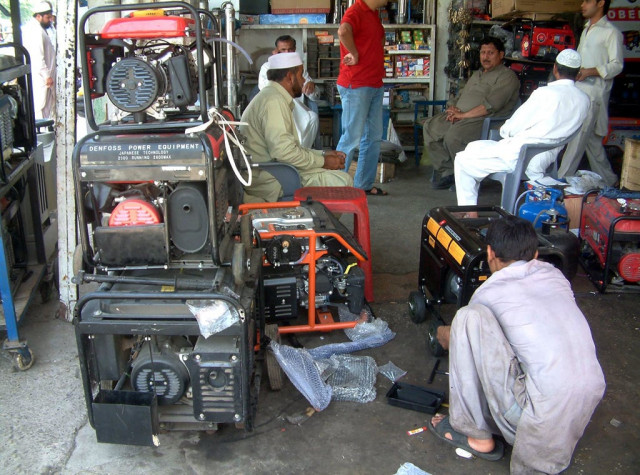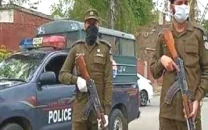Dark ages: The heat is on, the power is off
When a record heat wave comes amidst a record power crisis, the result is misery.

A mechanic busy in repairing power generators at his shop as demands for power generators has increased due to loadshedding. PHOTO: INP
It’s the perfect storm, Pakistan style. This Friday was the hottest day Lahore has suffered in the last 29 years, with the temperature shooting up as high as 47 degrees centigrade, a record according to the Pakistan Metrological Department. And on this sweltering Friday, the unlucky city of Lahore also experienced record levels of load-shedding, which lasted for up to twenty hours in some areas.
The power crisis has worsened in the last 48 hours, as cities and rural areas alike plunged into darkness after four power plants tripped due to overload. Believe it or not this was the good news, as the tripping of the power plants avoided the near-collapse of the National Grid System, similar to the one that took place on February 24.
While there are no easy fixes to this problem, despite what politicians may have claimed in their election campaigns, short-term relief is possible if enough money is injected to temporarily resolve the circular debt issue. But even that’s not happening. After making an initial commitment to interim Prime Minister Mir Hazar Khan Khoso to provide a sum of Rs22.5 billion to the water and power ministry, a defiant Ministry of Finance remains reluctant to release the remaining Rs17.5 billion for fuel purchases.
Currently, power stations are producing energy well below their capacity. Against the public sector’s available installed thermal capacity of 3,580MW, Friday’s production stood at a paltry 1,305MW.
Out of the 11 thermal power plants in the public sector, seven are completely shut down, while the rest of the power plants are not running at even one-third of their capacity due to fuel shortages and technical faults.
Independent Power Plants (IPPs) are also facing production shortfalls. With a generation capacity of 7,687MW, energy production at IPPs is currently at 5,024MW as most of the plants remained closed due to non-availability of fuel.
“In the past 10 days, I ran my plant for five days but only received payment for running it for a day and a half,” complained the Chief Operating Officer of Saif Power Plant Sohail Haidri.
Haidri threatened to shut his plant on Saturday, if the government did not clear his dues.




DESIGN: FAIZAN DAWOOD
Out of 26 IPPs, nine – with an accumulated generation capacity of 1,756MW – are currently shut down, and the rest are operating below capacity. The HUBCO power plant, for example, was producing only 18MW against a capacity of 214MW due to the government’s failure to pay outstanding dues of Rs14 billion.
Furthermore, there was a partial blackout in parts of the country on Thursday with a sudden shortage of 1,377MW from the system. Guddu power plant, Uch power plant, Habibullah Energy Limited and Engro Daharki all tripped on the same day.
The ministry of water and power’s decision to over-stretch the system to get 500MW more electricity caused the problem.
“We avoided a complete breakdown by isolating the problematic areas from the rest of the country,” said Zargham Eshaq Khan, the joint secretary power of the ministry of water and power.
On February 24, when the country plunged into darkness the power shortage due to the system’s trip was 900MW.
The situation remained almost the same on Friday. Cities like Lahore and Faisalabad faced power outages for 18 to 20 hours, while in Islamabad, most areas of the federal capital faced up to 10 hours of load shedding.
However, this is not an out-of-the-blue scenario, officials admit.
“There is no predictability in planning as there hasn’t been effective asset management over the years”, said Khan. “If I bring one plant on the system the other goes out.”
On Friday, average electricity generation stood at 10,200MW while the average demand was 15,000 MW. The breakdown of this is as follows: hydel generation was 3,144MW, which was 48.8% of the installed capacity. Thermal public sector generation was 1,305MW – just one-third of its installed capacity. IPP generation was 5,024MW, slightly less than two-thirds of the total generation capacity. Nuclear power generation was full at its capacity of 615MW.
The total generation was thus less than two-thirds of the available installed capacity of 16,261MW. Going by the numbers, load shedding in cities should not have been more than ten hours and in rural areas up to 12 hours. That is, if all else was equal. It’s not.
Khan explains the problem like this: Due to non-equitable load shedding, some areas faced the brunt of power shortfall more than others. Load shedding waivers given to hospitals, airports and military installations resulted into power outages in many areas.
Another element that is aggravating power outages, particularly in rural areas, is the corrupt elements in power distribution companies. The second-tier hierarchy in almost all the power distribution companies takes bribes to exempt certain areas from load shedding, according to sources. Where this is not possibly, they at least try and reduce the duration of power cuts.
The Ministry of Water and Power officials admit that they face difficulties in measuring the flow of power towards power distribution companies on a daily basis. “Based on a metering system, we get information after every month, but for load management purposes real time information was not available,” said Khan. He hoped that by June 30 the system would be installed that would allow them to get real time information.
Power protests in Faisalabad
Naturally, all this has an effect on the ground. People fed up with prolonged load-shedding took to the roads in Faisalabad on Friday and staged demonstrations against the Faisalabad Electric Supply Company (Fesco).
Zulfiqar Ahmad, a resident of Thikriwala, said, “We spent all Thursday night without electricity as power went out at about 8.00 pm on May 23 and came back at 5.00 am on May 24.”
Waheed Khaliq Ramay, chairman of the Council of Loom Owners Association (CLOA), led the protest and said that due to unprecedented load shedding, factory owners were unable to operate their units, leaving thousands of workers jobless. The elections may have symbolically empowered the people of Pakistan, but in a very literal sense, they remain powerless.
Published in The Express Tribune, May 25th, 2013.



















COMMENTS
Comments are moderated and generally will be posted if they are on-topic and not abusive.
For more information, please see our Comments FAQ